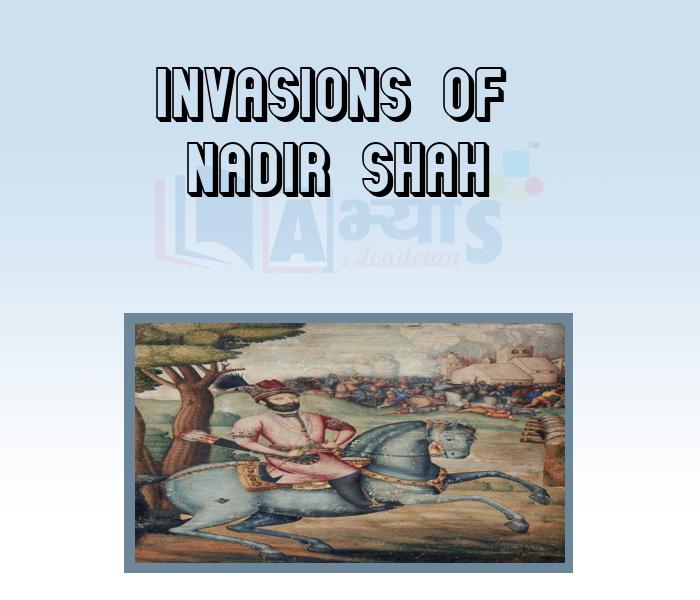Invasions of Nadir Shah











Invasions of Nadir Shah
INVASION OF NADIR SHAHCause:Nadir Shah wanted to empty Kandahar from the Afglians. Therefore, he asked the Mughal Emperor to close the Mughal frontiers around Kabul so that the Afghan rebels may not seek refuge in Kabul. The Emperor gave a confirming reply to Nadir Shah but did not do any thing practically. At this Nadir Shah sent an ambassador to the Mughal Emperor. The Empercr delayed in meeting him and kept him at Delhi for an entire year. Thns, Nadir Shah became furious with the Mughal Emperor. Also, looking at the weakposition of the Mughal Empire, Nadir Shah wanted to gain the rich treasures of India.Based on the above reasons, Nadi: Shah invaded India and decided to attack from Afghanistan. In May 1738, he attacked Northern Afghanistan. In the same month, he captured Gbhazni, in June, he captured Kabul and in Septemberm, Jalalabad also fell to him. In November, he surrounded the fortress of Peshawar and compietely razed it to the ground. Finally, in January 1739, he captured Lahore, the former capital of the Mughal Empire.Now Nadir Shah himself crowned Muhammad Shah as emperor on 12 May, and Muhammad Shah ceded the area west of river Indus to Nadir Shah. They both switched crowns according to the Persian tradition of friendship and the Kch-i-Noor diamond was lost Then Nadir Shah went back to Fersia. The emperor continued but finally died on 26 April 1748.
Last days of the Mughal Empire:Ahmad Shah and Alamgir II were the next Maghals to ascend the throne. While Ahmad Shah ruled from 1748 to 1754, Alamgir had governed from 1754 to 1759. However, these two emperers were too weak to tackle the already existing problems. The last nail to the coffin of the Empire was the coasecutive assaults of Ahmad Shah Abdali, an Afgan ruler, fom the northwest. He made successful invasicns on 1748, 1749, 1752, 1756, 1757 and 1759. Shah Alam 11 and his successors were only puppets in the hands of theirown nobles or British rulers or the Marathas. In 1803, the Britons captured Delhi and conilict with the existing Mughal emperors continued until 1858, when the last of the Mughal Emperors, Bahadur Shah Zafar was sent to exile in Rangoon.
______________asked the Mughal Emperor to close the Mughal frontiers around Kabul so that the Afghan rebels may not seek refuge in Kabul ? | |||
| Right Option : A | |||
| View Explanation | |||
In Mughal Era, which ruler became furious with the Mughal Emperor ? | |||
| Right Option : C | |||
| View Explanation | |||
In 1803, who captured Delhi and his conflict with the existing Mughal emperors continued until 1858? | |||
| Right Option : B | |||
| View Explanation | |||
Students / Parents Reviews [10]
My experience was very good with Abhyas academy. I am studying here from 6th class and I am satisfied by its results in my life. I improved a lot here ahead of school syllabus.

Ayan Ghosh
8thAbhyas is a complete education Institute. Here extreme care is taken by teacher with the help of regular exam. Extra classes also conducted by the institute, if the student is weak.

Om Umang
10thA marvelous experience with Abhyas. I am glad to share that my ward has achieved more than enough at the Ambala ABHYAS centre. Years have passed on and more and more he has gained. May the centre flourish and develop day by day by the grace of God.

Archit Segal
7thAbhyas Methodology is very good. It is based on according to student and each child manages accordingly to its properly. Methodology has improved the abilities of students to shine them in future.

Manish Kumar
10thAbout Abhyas metholodology the teachers are very nice and hardworking toward students.The Centre Head Mrs Anu Sethi is also a brilliant teacher.Abhyas has taught me how to overcome problems and has always taken my doubts and suppoeted me.

Shreya Shrivastava
8thI have spent a wonderful time in Abhyas academy. It has made my reasoning more apt, English more stronger and Maths an interesting subject for me. It has given me a habbit of self studying

Yatharthi Sharma
10thMy experience with Abhyas is very good. I have learnt many things here like vedic maths and reasoning also. Teachers here first take our doubts and then there are assignments to verify our weak points.

Shivam Rana
7thIt was a good experience with Abhyas Academy. I even faced problems in starting but slowly and steadily overcomed. Especially reasoning classes helped me a lot.

Cheshta
10thBeing a parent, I saw my daughter improvement in her studies by seeing a good result in all day to day compititive exam TMO, NSO, IEO etc and as well as studies. I have got a fruitful result from my daughter.

Prisha Gupta
8thMy experience with Abhyas academy is very good. I did not think that my every subject coming here will be so strong. The main thing is that the online tests had made me learn here more things.
